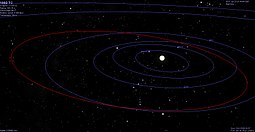astro.wikisort.org - Asteroid
(7474) 1992 TC is a large sized M-type asteroid discovered by Robert H. McNaught in 1992. It is notably one of a few similar M-type asteroids, including the named asteroids 4660 Nereus and 65803 Didymos, which can be reached easily by spacecraft from Earth. The delta-V required to reach 7474 (1992 TC) would be about 5.6 kilometres per second (3.5 mi/s),[3] which is less than is needed to reach the moon. M-type asteroids are thought to be composed primarily of nickel and iron, which if proven to be true means that 7474 (1992 TC) may one day become an important source of raw materials in space.
 | |
| Discovery | |
|---|---|
| Discovered by | McNaught, R. H. |
| Discovery site | Siding Spring |
| Discovery date | 1 October 1992 |
| Designations | |
MPC designation | 7474 |
Alternative designations | 1992 TC |
| Orbital characteristics[1] | |
| Epoch 13 January 2016 (JD 2457400.5) | |
| Uncertainty parameter 0 | |
| Observation arc | 9008 days (24.66 yr) |
| Aphelion | 2.023428544361125 AU (302.70060175002 Gm) |
| Perihelion | 1.107744504781589 AU (165.71621919495 Gm) |
Semi-major axis | 1.565586524571357 AU (234.20841047248 Gm) |
| Eccentricity | 0.2924412113952760 |
Orbital period (sidereal) | 1.96 yr (715.51 d) |
Mean anomaly | 319.6698827668740° |
Mean motion | 0° 30m 11.302s / day |
| Inclination | 7.087399865368700° |
Longitude of ascending node | 88.65316330200990° |
Argument of perihelion | 275.5510819132080° |
| Earth MOID | 0.166416 AU (24.8955 Gm) |
| Physical characteristics | |
Mean diameter | 670–1500 meters[2] |
Synodic rotation period | 5.540 h (0.2308 d) |
Spectral type | X |
Absolute magnitude (H) | 18.0[1] |
With an absolute magnitude of 18.0,[1] the asteroid is about 670–1500 meters in diameter.[2] On 2031-Aug-11 the asteroid will pass 0.085 AU (12,700,000 km; 7,900,000 mi) from Mars.[1]
References
- "JPL Small-Body Database Browser: 7474 (1992 TC)". Jet Propulsion Laboratory. Retrieved 4 April 2016.
- "Absolute Magnitude (H)". NASA/JPL. Archived from the original on 2 March 2001. Retrieved 25 June 2014.
- "Delta-v for spacecraft rendezvous with all known near-Earth asteroids". 2010. Archived from the original on 3 June 2001. Retrieved 7 October 2010.
External links
- (7474) 1992 TC at NeoDyS-2, Near Earth Objects—Dynamic Site
- Ephemeris · Obs prediction · Orbital info · MOID · Proper elements · Obs info · Close · Physical info · NEOCC
- (7474) 1992 TC at ESA–space situational awareness
- (7474) 1992 TC at the JPL Small-Body Database
Другой контент может иметь иную лицензию. Перед использованием материалов сайта WikiSort.org внимательно изучите правила лицензирования конкретных элементов наполнения сайта.
WikiSort.org - проект по пересортировке и дополнению контента Википедии